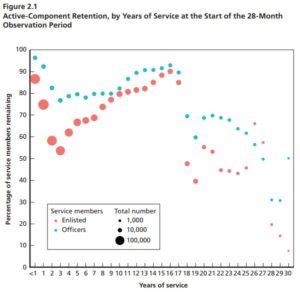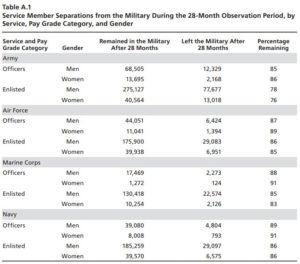Report: Male Victims Are Especially Likely to End Their Service
WASHINGTON — In addition to the extreme trauma it causes victims, military sexual assault also makes it much more difficult for the U.S. military to retain good personnel, according to a new report.
In fact, exposure to sexual assault was found to double the odds that a servicemember would leave the military within 28 months. The new report from the RAND Corp. calculated that sexual harassment, which did not involve actual touching of the victim, was associated with roughly 8% of all military separations during the same time period.1
“Sexual assault and sexual harassment have a variety of consequences harmful to those who are targeted, including psychological and physical health effects,” the authors wrote.” In addition, sexual assault and harassment may have deleterious and costly consequences for employers if the abuse results in higher turnover or low morale and productivity. This report describes data analyses designed to assess the effects of sexual assault and sexual harassment on service members’ decisions to separate from the military.”
According to surveys by RAND, sexual assaults were associated with 2,000 more separations than would normally be expected; another 8,000 separations were associated with sexual harassment, the report added.
“Sexual assault and sexual harassment are associated with a wide range of harms to individual servicemembers, but this study highlights another negative impact of these crimes—higher rates of attrition and associated harms to force readiness.” said lead author Andrew Morral, PhD, senior behavioral scientist at nonprofit, nonpartisan RAND. “We estimate that sexual assaults and harassment of servicemembers that occurred in a single year were associated with the premature loss of at least 16,000 person-years of service over the following 28 months.”
DoD reported last year that the number of sexual assault reports by servicemembers increased by 3% in fiscal Year 2019, compared to FY 2018. The military services received 6,236 reports in FY 2019 from personnel indicating they experienced a sexual assault, up from 6,053 in FY 2018.
Slowly Improving
“This year’s focus group feedback indicates that military culture is heading in the right direction, albeit slowly,” DoD said in an annual report to Congress. “Servicemember participants believed senior leaders actively drove change in their units. Previously admissible ‘locker room’ behaviors face greater scrutiny today, in part due to younger servicemembers being more aware of what constitutes inappropriate behavior. Participants indicated that generational differences may impact progress in enhancing healthy workplace climates.”
Separations from the military following sexual assault or sexual harassment are disproportionately voluntary, with the servicemember opting not to reenlist for their own reasons, the authors explained. Not only is military readiness affected, but those who leave military service early forego substantial future compensation.
Interestingly, while it is a trend that affects both men and women, according to RAND, men are especially likely to seek voluntary separations following a sexual assault or sexual harassment.
Recommendations to the DoD on combatting these issues include prioritizing sexual harassment training, prevention and response for both men and women in the military. The report also called for future studies on how reporting a sexual assault affects separation.
The report was based on the 2014 RAND Military Workplace Study and military separation data from 2015-2016. The study was completed in 2019 and recently cleared for publication by DoD’s Sexual Assault Prevention and Response Office (SAPRO); it is the latest in a series of reports that take a more detailed look at specific findings from the initial survey which invited more than 560,000 U.S. servicemembers to share their experiences.
“In this report, we seek to quantify the effects of sexual assault and sexual harassment on separations from the U.S. military and, by extension, the effects on military costs and readiness; one way we do this is by considering the number of person-hours associated with separations that are earlier than would otherwise be expected,” the authors explained. “Specifically, we examine all separations, whether these occurred because servicemembers voluntarily chose not to reenlist or continue their service as an officer or because they were discharged from the military for reasons other than their choice not to renew their commitment to serve. In addition, we examine the reasons recorded for these separations and whether the servicemembers whose survey responses led us to classify them as having been sexually assaulted or sexually harassed were more likely to (1) leave the military of their own volition or (2) be discharged for reasons associated with their failure to meet expectations for their performance or conduct.”
The authors cautioned that the actual numbers of military separations caused by sexual assault and sexual harassment are likely underestimated because the study only reflects a 28-month window of time.
- Morral, Andrew R., Miriam Matthews, Matthew Cefalu, Terry L. Schell, and Linda Cottrell, Effects of Sexual Assault and Sexual Harassment on Separation from the U.S. Military: Findings from the 2014 RAND Military Workplace Study. Santa Monica, CA: RAND Corp., 2021. https://www.rand.org/pubs/research_reports/RR870z10.html. Also available in print form.



